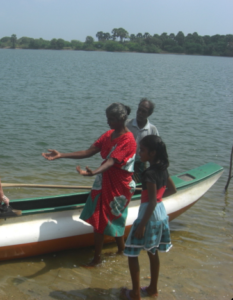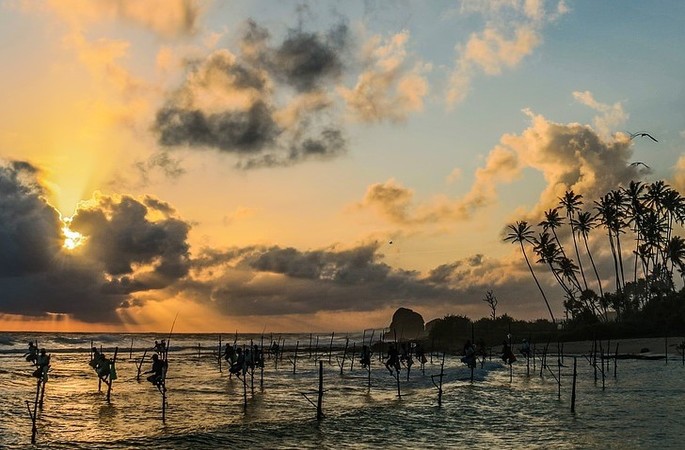After completing my PhD studies in Norway, the first research project that I involved in was geographically located in eastern Sri Lanka, which focused on ‘post-war recovery’. I was so enthusiastic about involving in the project. Wow! it is Batticaloa in Eastern Sri Lanka. It is called the land of singing fish. Batticaloa has always excited me not simply because of my ancestral origin but because of the natural beauty of the sea, lagoons and white sandy beaches. It is one of the places where I spent my school vacation with my family in my grandparents’ home. The nostalgic memory of some food such as lagoon prawns, fish curry, thiray keerai, thumbangaay curry, cashew curry, curd and paal appam yumm… my taste buds still cannot forget those amazing dishes prepared by my aunts.
In Batticaloa, we have ancestral family land in a small village adjoining the Panichankerni lagoon. When I was a child, I have travelled to our land in this village called Vakarai with my relatives in a bullock cart. I enjoyed cashews and mangoes on the way. All these connection came to a halt with the breakout of the war between the government of Sri Lanka and the Liberation Tigers of Tamil Elam (LTTE), which lasted nearly three decades. The LTTE fought for a separate Tamil homeland in the North and East of the island. Because of the war, we could not go to our land or visit our grandparents. During the ceasefires and peace prevailing periods, my father took us on a challenging journey to his homeland. We had to pass dozens of military checkpoints before we reach our grandparents home in Kathankudy in Batticaloa.
Vakarai was one of the heavily affected villages in the east by the protracted war. It was one of the LTTE strongholds and a heavy battleground that encountered severe loss of lives. Adding to this human-made disaster, in 2004, the tsunami in the Indian Ocean severely hit the eastern region of Sri Lanka, which claimed the lives of thousands of people and wiped out the coastal areas, including Vakarai. In 2007, the Sri Lankan military took control of eastern Sri Lanka, and the LTTE lost its stronghold. In 2009, the devastating war concluded on the island with a military victory. The war-affected east then started to resume normalcy gradually, and it was the period that I started my research project in the east. The research team selected Vakarai as the study area.
Revisiting
I let my imagination run away with all the childhood memories loaded in my mind; I was keen to see how Vakarai has changed after the war and tsunami. When I got there, it looked entirely different for me. On our way, I noticed signboards saying ‘uncleared landmine area’ and scars of the battle left on the walls of houses, schools and other buildings. As I walked around the village, my childhood memories flashing before my eyes. Yet, I couldn’t see Vakarai as it is stored in my childhood memories. It looked like a whole new place to me. What struck me the hardest when I walk around was the feeling of the haunting emptiness of this village. Evidence of development and disasters co-existed side by side; fallen Palmyra trees, shelled houses, military checkpoints, army camps, newly built national school (which, of course, is too big for Vakarai), widened roads and newly constructed bridges. All these appeared to me as an unpromising physical development in the name of post-war development. I could see the failures of not recognising the complexity of the needs of war-affected people. Those needs are not fully absorbed into the large-scale infrastructural development. When tackling a post-war development plan, the most vulnerable should be identified and included. Writing about the mismatch of actual needs of the people and ongoing development requires another piece of writing…..Hence, I stop here and turn to the main character of this write-up.
Selvaraniyamma

As the latest research in Vakarai, I involved in a research project on ‘gender and fishing’, which commenced in 2018. Under this research project, I met Selvaraniyamma, who was 60 years old and a popular fisherwoman. She had a slim body, a smiling face and a steady walk. I could see her inner strength from the way she talked with me. She is an excellent diver. Living closer to the lagoon, she is a good swimmer too. Selvaraniyamma had started to swim and dive when she was ten years old. During her childhood, the village was very much disconnected from the rest of the country. The village community was a closely knitted one.
The villagers have not given any importance to education, and girls were stopped from schooling after they attained puberty. Slevaraniyamma’s parents have not sent her to school as they could not afford to spend on her education. She started to talk about how things happened during ‘her days’. When she was growing up, as she told, Vakarai was a different land. She recalled that the villagers had a happy life as they had an abundance of rice, fish, palmyrah and coconuts. Her parents were passionate fishers. Each family had grown fruits and vegetables in their backyard. She said: “we grew up in the village with nature. My happiest childhood memories were helping my parents in the garden and swimming in the lagoon with my friends… I never thought our lives would be tough. We lost everything during the war and tsunami.” Selvaraniyamma’s family had to undergo multiple displacements within and outside her village during those difficult phases. The multiple displacements disrupted the education of her children and their livelihood. She said that sometimes they had to leave everything and run for their lives depending on the intensity and severity of the war.
Consequently, she said that her house was looted, she lost her important documents such as birth certificates, identity cards, land title documents, jewellery, and cash. When she recalled her past, I could see the stored tears continue to flow down her dry cheeks. She lost her ability to speak for a while. She dashed her tears with the sleeves of her long gown. After the war, many families in the village had to start their lives from scratch. This is not only the story of Selvaraniyamma but many women in the village.
She slowly changed the topic to talk about her married life.
Selvaraniyamma got married at the age of 20 to a lorry driver from Kandy, who used to pass Vakarai on his way to Trincomalee to transport essential goods from Kandy. Selvaraniyamma’s marriage was a love marriage.
She was considered as one of the fortunate women in her village as she got married to a husband from the city of Kandy, which is located in the central highlands of Sri Lanka. They had a happy married life. They had two daughters and a son. They all managed to survive in the war and tsunami. Selvaraniyamma has hidden her elder daughter several times from LTTE, who recruited child soldiers forcefully. All three children have passed away at the ages of 28, 25 and 22 within a year. She cried and said that she did not lose any of her children due to war or the tsunami. Her daughter’s husband killed her elder daughter, and the other two children died of illnesses. Now, she and her husband are looking after their grandchildren. Her husband is old and sick now. He cannot engage in any economic activities to earn for the family. However, he provides his support in taking the grandchildren to school and looking after them during the night when Selvaraniyamma goes to the shore.
Slevaraniyamma is earning her daily bread by engaging in fishing. She goes to the lagoon in the evening to caste the net. The lagoon is nearly one kilometre away from her home. After that, she comes home to prepare dinner for her grandchildren and husband. Around 10 p.m., she goes back to the lagoon, check the net and stays there to protect her net from being stolen. She has to wait until the following day to pull her fishing net. On some days, one of her childhood friends accompanies her. If not, she stays all by herself closer to the lagoon. After collecting the catch, she comes home early morning to prepare the meals for her grandchildren and help them to go to school. Selvaraniyamma catches around 3-5 Kilos of fish per day. She depends on her brother to sell her catch. If she sells in the village, she cannot get a reasonable price. Her brother helps her sell her catch in the nearby town, which is not accessible to Selvaraniyamma regularly due to her household responsibilities. She also keeps some of her fish for their consumption. She makes dry fish too when she cannot sell her fish to her brother. As fishing is seasonal, Selvaraniyamma needs to borrow money for the household expenditures and her grand children’s education during the off-seasons. She is very optimistic that her grandchildren would bring a promising future for the family after their education.
Women and fishing: A different narrative
Women in Sri Lanka have been involved in fisheries for a long time. However, their role in fisheries is mainly confined to post and pre-harvest activities. In these sectors, women do play an ancillary role. In terms of pre-harvest activities, women involve in mending nets, preparing the nets, and preparing food for fishers. They also help in carrying nets and other fishing equipment to the shore. In post-harvest activities, women’s role is mainly limited to fish processing (making dry fish, sorting, freezing, and packing) and trading. They involved in the fisheries sector by extending their domestic roles. Although Sri Lankan women make a considerable contribution to fisheries and their households through their participation in fisheries, their roles are undervalued and neglected. They have to constantly renegotiate and rework their roles with the changing local and global socio-economic contexts.
Women’s direct involvement in fisheries as fishers has been limited to gleaning and collecting shellfish, seaweed and crabs. Some women involved in these activities as a supplementary income source or to meet their daily food needs. In many coastal areas, women do not directly involve in fishing due to cultural taboos and culturally recognised customs and traditions that stand in their way. Some women are not even allowed to touch a boat. Women in fishing communities experience various discrimination and taboos in different cultures across the island in their direct involvement in fishing. Contrary to the accepted gender role in fisheries, women in Vakarai are involved in fishing, directly in this context of the country.
Selvaraniaymma and many other women in Vakarai make their daily ends meet by directly involving in fishing. The decision to support their families through their precarious and vulnerable livelihoods in fishing unfolds the stories of success, failures, pains and expectations. They cannot access markets outside the village due to their household responsibilities, transport and competition from their rival male counterparts. Most of the women who directly involved in fishing are either the sole or the main economic contributor to their household as they are widowed, divorced, separated, abandoned or unmarried. Women do not participate in decision making in fisheries-related matters in the village. They are not members of the village fishing organisation. They do not simply have the space to address their issues.
With a future of fishing threatened by various challenges, the next generation of fishing families in the village might move out from their traditional livelihoods. However, in a context where many female-headed households can’t move out from fisheries or the village, their poverty and vulnerability will undoubtedly transfer to the next generation.
Although some fishing women are economically independent, they are socially and politically incapacitated. As formal options for viable livelihoods are not available and very fragile, new entrants to the fisheries sector are increasing in the village. Women in the fisheries have to face the challenge of growing competition for fishing by the new entrants. Former fishing grounds of the small-scale fishers in eastern Sri Lanka have gradually been lost to large-scale tourism and other development projects. It is important to note that the post-war development activities in the village did not fully understand the villagers’ needs in terms of their livelihoods and how livelihoods in the village are organised in the line of gender. With the increasing focus on the blue economy as a potential path of development, Selvaraniyamma’s story triggers a question on the real meaning of the SDG goal 14, “Life below water”. Could it also include women like Selvaraniyamma or just the biological diversities of Oceans and sea? Like Selvaraniyamma, women making their livelihoods through fishing do cry silently in the land of singing fish.



